当前位置:网站首页>[pointer training - eight questions]
[pointer training - eight questions]
2022-07-06 02:49:00 【Fighting Yang!】
`
Analysis of eight written examination questions

Every day I don't dance , It's all a betrayal of life .
subject :
Pen test 1
int main()
{
int a[5] = {
1,2,3,4,5 };
int* ptr = (int*)(&a + 1);
printf("%d,%d", *(a + 1), *(ptr - 1));//2 5
return 0;
}
// What is the result of the program ?
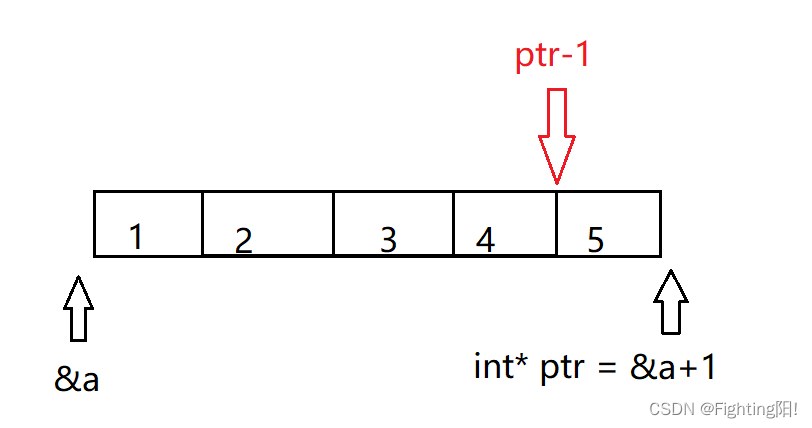
a Represents the first address of this array ,&a Is the address of the entire array , Therefore, it is in progress (&a+1) In the process of operation ,+1 Operation skipped a Entire array , because a It's an array ,&a Represents an array pointer , In assignment ptr The process of , On the left is the shaping pointer , On the right is the array pointer , The types on both sides are different , So use (int*) take (&a+1) Strong conversion to integer pointer type , Otherwise, a warning will be generated . So for *(a+1),a+1 by 2 The address of ,(a+1) Namely 2,ptr-1 by 5 The address of ,(ptr-1) Namely 5.
Pen test 2
struct Test
{
int Num;
char* pcName;
short sDate;
char cha[2];
short sBa[4];
}*p;// namely p = (struct Test*)0x100000
// hypothesis p The value of is 0x100000. What are the values of the expressions in the following table ?
// It is known that , Structure Test The variable size of type is 20 Bytes
int main()
{
printf("%p\n", p + 0x1);
printf("%p\n", (unsigned long)p + 0x1);
printf("%p\n", (unsigned int*)p + 0x1);
return 0;
}
0x Express 16 Base number ,0x1 representative 1, because p It's the pointer type , The pointer +1 Or minus 1 Represents the size of skipping this type , namely :
(1) A shaping pointer +1 Represents skipping an integer
(2) A structure pointer +1 Represents skipping a structure
(3) A character pointer +1 Represents skipping a character
( Company : byte )
so p+0x1 Represents skipping this structure (20 byte ), turn 16 Hexadecimal is 14, so p+0x1 by 0x100014;(unsigned int)p Represents the general shaping type , so +1 It represents this integer number +1, It's not an operation between addresses ,(unsigned int)p+0x1 by 0x100001;(unsigned int*)p Forcibly convert pointer of structure type to pointer of unsigned integer , so +1 The skipped step size is from 20 Turned into 4, namely (unsigned int*)p+0x1 by 0x100004.
Pen test 3
int main()
{
int a[4] = {
1, 2, 3, 4 };
int* ptr1 = (int*)(&a + 1);
int* ptr2 = (int*)((int)a + 1);
printf("%x,%x", ptr1[-1], *ptr2);
return 0;
}
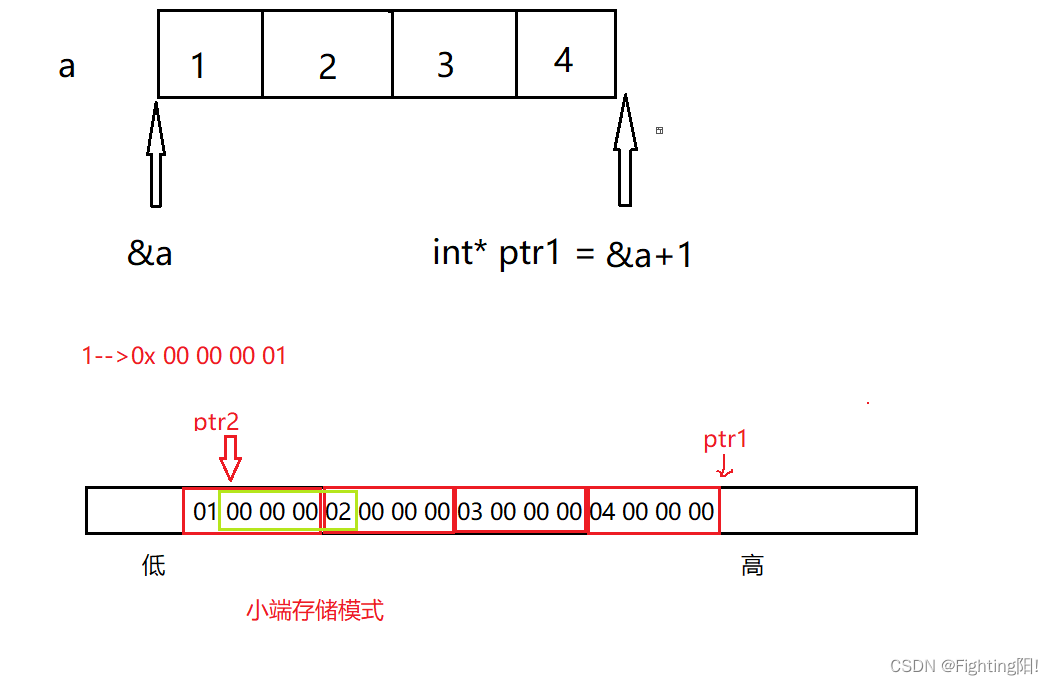
about ptr1 Operation and written test questions 1 Same operation ,ptr1[-1] Express *(ptr1-1), That is to say 4;
about ptr2 The operation of , hypothesis a The address for 0x0012ff40, When strong turns into int Type , That is, it represents an integer 0x0012ff40 so (int)a+1 It stands for numbers 0x0012ff41, And then force it to (int*) type , It becomes an address again , That is to say a The original address has been moved one byte to the right , so ptr2 The pointing position is shown in the figure , Because it is int*, Therefore, you need to start from ptr2 The position pointed to starts counting until the fourth byte 00 00 00 02,, Because it is a small end storage mode ( The last one mentioned ), Therefore, the reading should be from high address to low address ,02 00 00 00, Because the address book is 16 Base number ,%x Printing is 20000000
Pen test 4
int main()
{
int a[3][2] = {
(0, 1), (2, 3), (4, 5) };
int* p;
p = a[0];
printf("%d", p[0]);
return 0;
}
Before that , We need to note that the result of the comma expression is the last number , namely a[3][2] The internal number of is :{
1,3,
5,0,
0,0}
a[0], Represents the array name of the first row of the matrix , so p Represents the first row of array name ,p[0] = a[0][0] = 1;
Pen test 5
int main()
{
int a[5][5];
int(*p)[4];
p = a;// There will be a warning , But it can still be implemented
printf("%p,%d\n", &p[4][2] - &a[4][2], &p[4][2] - &a[4][2]);
return 0;
}
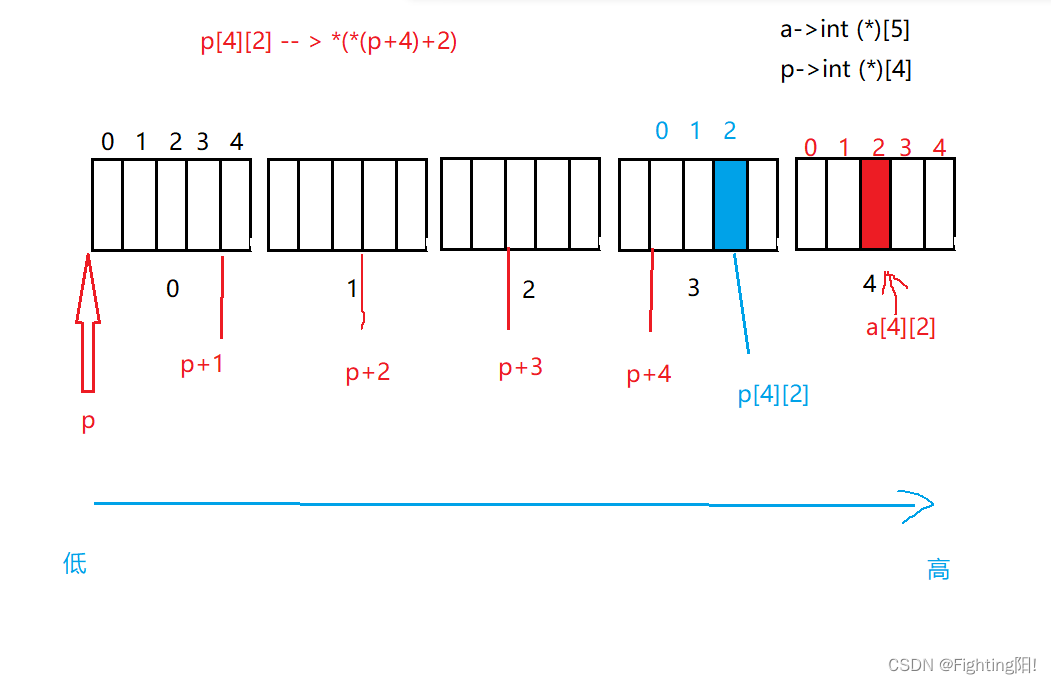
From the above code we can see ,a by int [5[[5],p by int(*)[4], Due to type mismatch , Therefore, a warning will occur during assignment , But it can still run , By drawing , We can see that p[4][2] And a[4][2] The exact location of , Address - The address is equal to the number of elements that differ between addresses , Therefore, in order to %d The result is -4; When we use %p When printing , according to -4 The original code of :10000000000000000000000000000100,
Find the inverse code :111111111111111111111111111111111011, Then find the complement :111111111111111111111111111111111100, Can be reduced to ff ff ff fc
Pen test 6
int main()
{
int aa[2][5] = {
1, 2, 3, 4, 5, 6, 7, 8, 9, 10 };
int* ptr1 = (int*)(&aa + 1);
int* ptr2 = (int*)(*(aa + 1));
printf("%d,%d", *(ptr1 - 1), *(ptr2 - 1));
return 0;
}
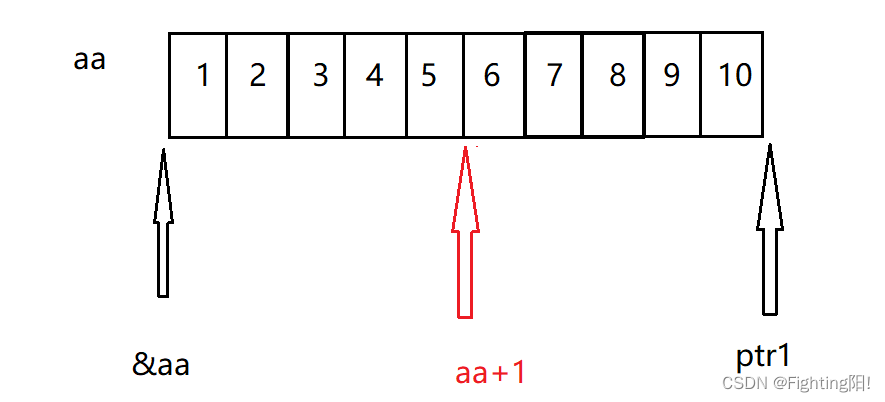
After the explanation of several questions , This problem is similar to the previous ones , The main thing is to turn the graph into a line , Instead of two lines , So the result is 10 5
Pen test 7
int main()
{
char* a[] = {
"work","at","alibaba" };
char** pa = a;
pa++;
printf("%s\n", *pa);
return 0;
}
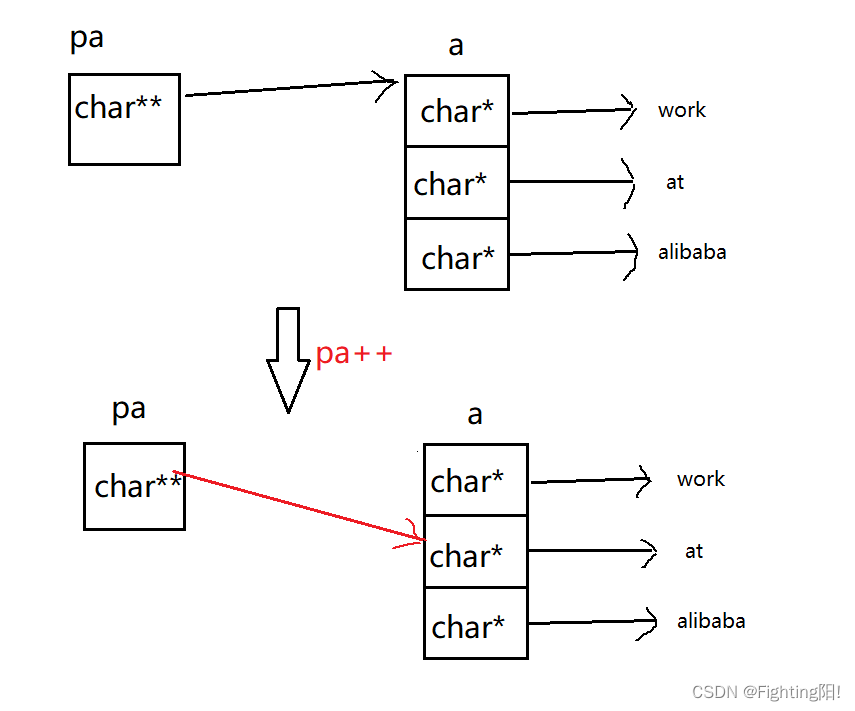
The array name represents the address of the first element , When put a Assign a value to pa when ,pa Yes a The address of , because pa by char** namely pa++ The size of the move is one char* size , Therefore, it is shown in the figure ,pa Point to (a+1),*pa representative :
*(a+1) namely a[1], That is to %s Print a[1], The result is at.
Pen test 8
int main()
{
char *c[] = {
"ENTER","NEW","POINT","FIRST"};
char**cp[] = {
c+3,c+2,c+1,c};
char***cpp = cp;
printf("%s\n", **++cpp);
printf("%s\n", *--*++cpp+3);
printf("%s\n", *cpp[-2]+3);
printf("%s\n", cpp[-1][-1]+1);
return 0;
}
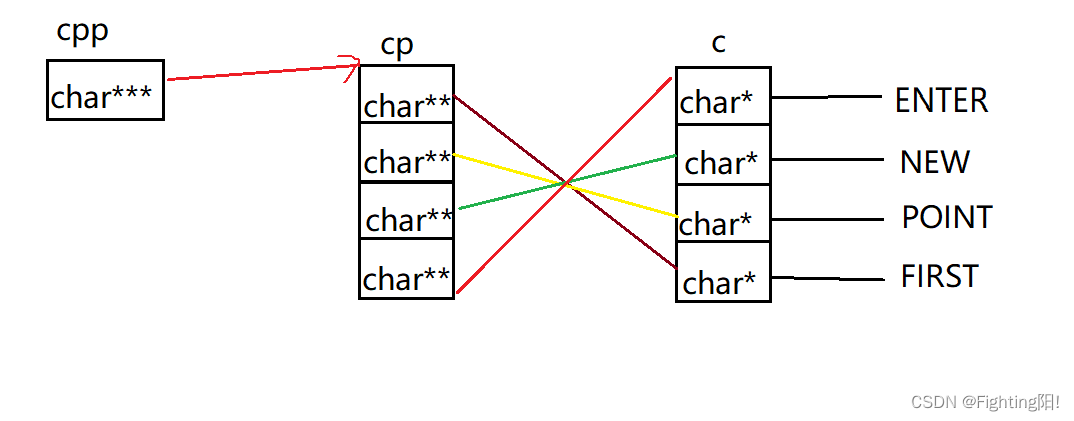
Appear as the last question , It's bound to be troublesome , therefore , We need to find out the relationship between them , That is, the association between the first three lines of code , Pictured above .
1) When we execute the first printf when ,++cpp, be cpp Yes cp[1], namely :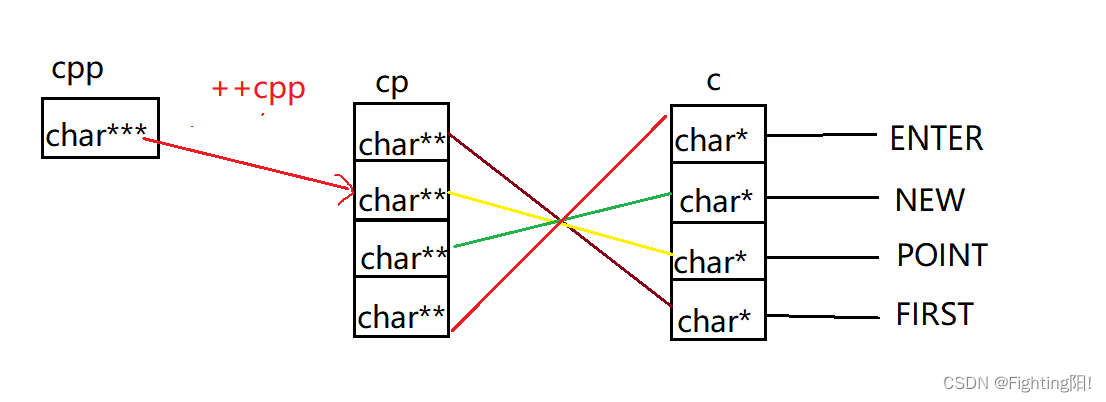
so **cpp Is to dereference the connection bit by bit ,*cpp find cp[1],
**cpp find c[2], Final print POINT;
2) When we execute the second printf when , also ++cpp, Point to cp[2], And then I'll explain the quotation , That is, find the next level through the connection , That is, to arrive at cp[2],–cp[2], namely cp[2] From to c[1] To point to c[0], And then I'll explain the quotation , arrive ENTER The first address , Again +3, arrive ER, namely :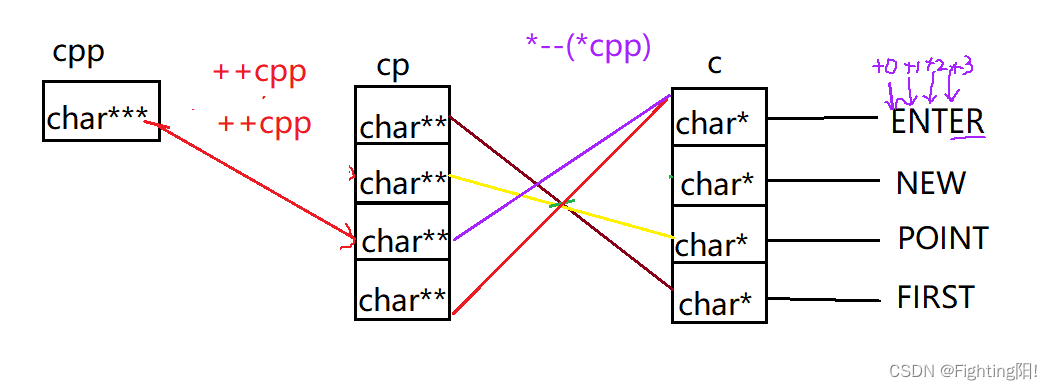
3) When we execute the third printf when , Convertible :
namely cpp-2 by cp[0] The address of , Dereference becomes cp[0], Then de quote as c[3],c[3] As array name , by FIRST First element F The address of ,+3 by S The address of , So the result is ST;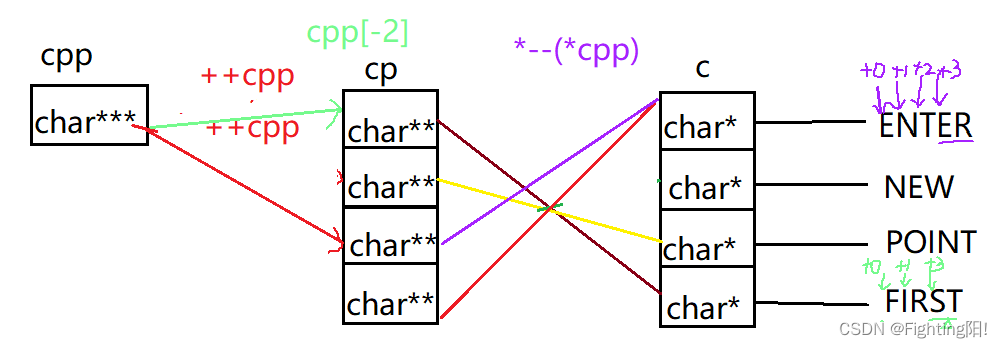
4) When we execute the fourth printf when , Follow the above method of finding line segments , Not hard to find :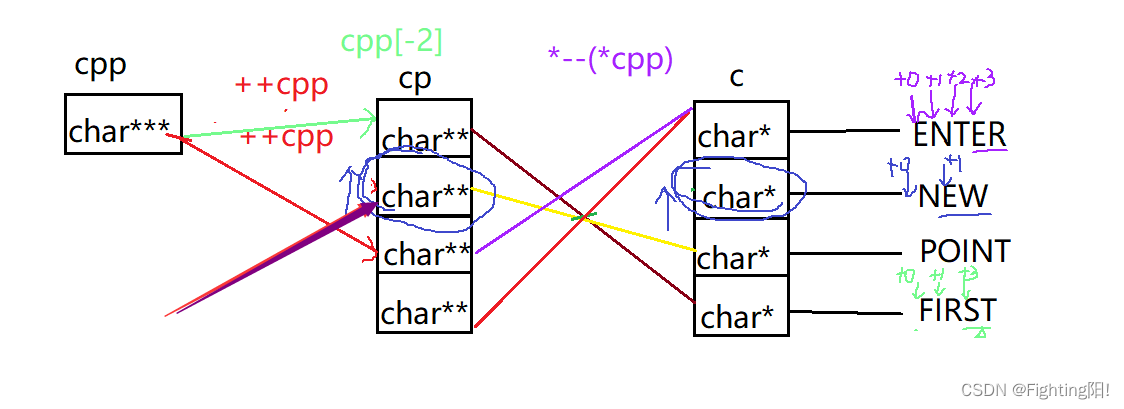
The result is EW.
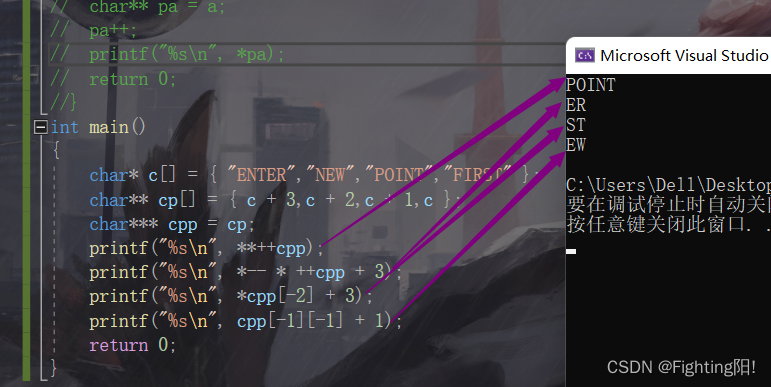
summary :
Through the training of the above eight questions , It includes the operation of pointer core and the most difficult part , It's not hard to see. , Drawing and drawing well is the ultimate means to subdue all pointer relationships .
边栏推荐
- 2.11 simulation summary
- 张丽俊:穿透不确定性要靠四个“不变”
- MySQL winter vacation self-study 2022 11 (7)
- 力扣今日题-729. 我的日程安排表 I
- Redis installation
- js 正则过滤和增加富文本中图片前缀
- 2.13 simulation summary
- Universal crud interface
- Blue Bridge Cup group B provincial preliminaries first question 2013 (Gauss Diary)
- Déduisez la question d'aujourd'hui - 729. Mon emploi du temps I
猜你喜欢

A doctor's 22 years in Huawei
![[network security interview question] - how to penetrate the test file directory through](/img/48/be645442c8ff4cc5417c115963b217.jpg)
[network security interview question] - how to penetrate the test file directory through
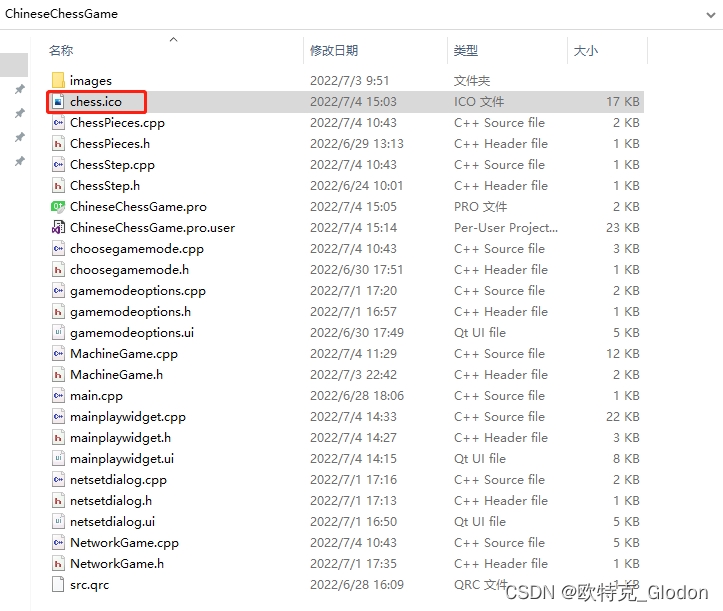
Pure QT version of Chinese chess: realize two-man, man-machine and network games
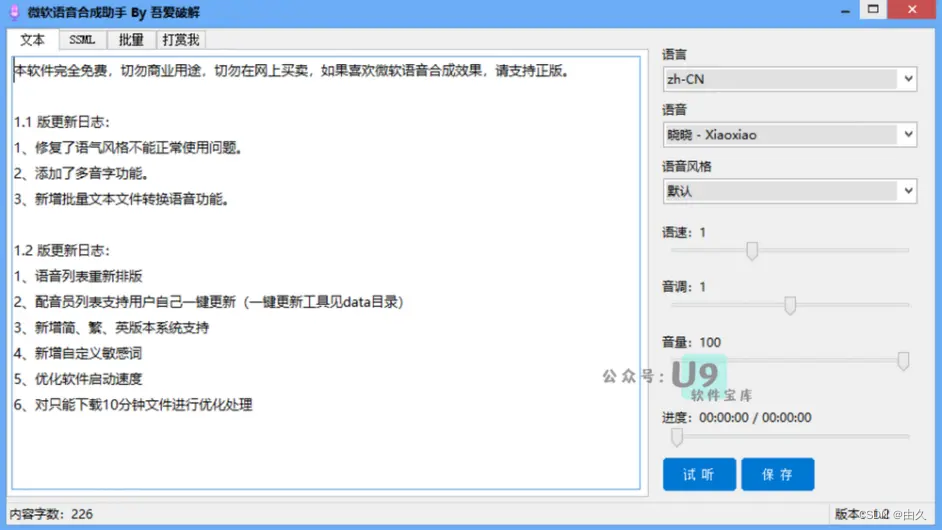
Microsoft speech synthesis assistant v1.3 text to speech tool, real speech AI generator

【Unity3D】GUI控件
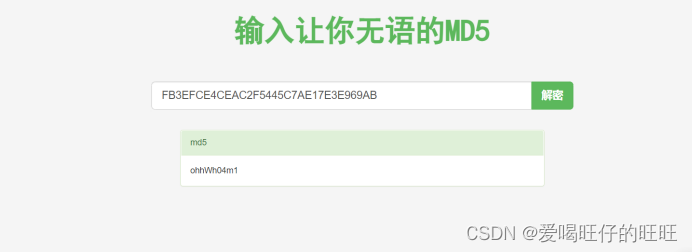
Misc (eternal night), the preliminary competition of the innovation practice competition of the National College Students' information security competition
![[Yunju entrepreneurial foundation notes] Chapter II entrepreneur test 15](/img/72/0fe9cb032339d5f1ccf6f6c24edc57.jpg)
[Yunju entrepreneurial foundation notes] Chapter II entrepreneur test 15
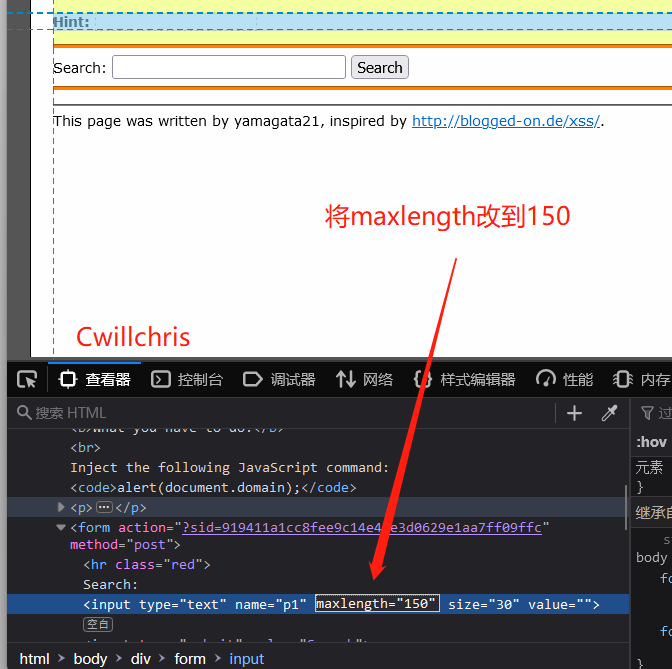
XSS challenges绕过防护策略进行 XSS 注入
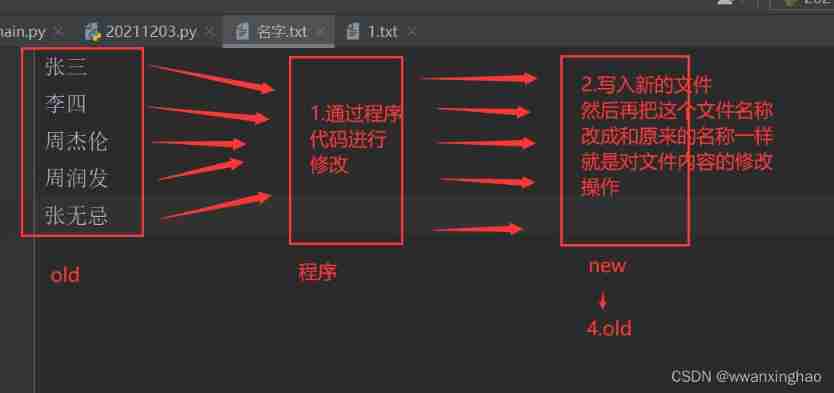
4. File modification

深度解析链动2+1模式,颠覆传统卖货思维?
随机推荐
华为、H3C、思科命令对比,思维导图形式从基础、交换、路由三大方向介绍【转自微信公众号网络技术联盟站】
Redis delete policy
[Yunju entrepreneurial foundation notes] Chapter II entrepreneur test 18
Looking at the trend of sequence modeling of recommended systems in 2022 from the top paper
[Yunju entrepreneurial foundation notes] Chapter II entrepreneur test 14
A doctor's 22 years in Huawei
[Digital IC manual tearing code] Verilog asynchronous reset synchronous release | topic | principle | design | simulation
[Yunju entrepreneurial foundation notes] Chapter II entrepreneur test 11
How to improve the enthusiasm of consumers when the member points marketing system is operated?
[ruoyi] enable Mini navigation bar
Technology sharing | what if Undo is too big
Déduisez la question d'aujourd'hui - 729. Mon emploi du temps I
What is the investment value of iFLYTEK, which does not make money?
Li Kou today's question -729 My schedule I
How to read excel, PDF and JSON files in R language?
【若依(ruoyi)】ztree 自定义图标(iconSkin 属性)
会员积分营销系统操作的时候怎样提升消费者的积极性?
Taobao focus map layout practice
"Hands on learning in depth" Chapter 2 - preparatory knowledge_ 2.5 automatic differentiation_ Learning thinking and exercise answers
Master data management theory and Practice